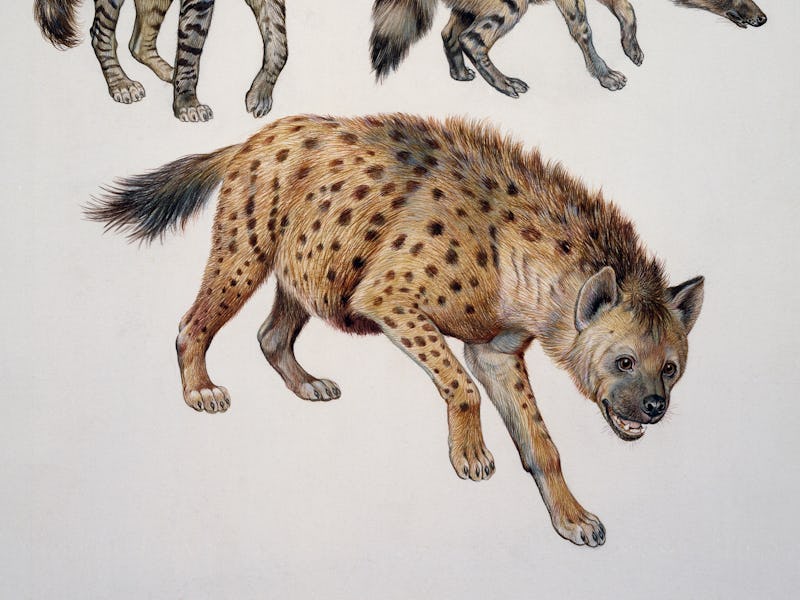What nature’s villain can teach us about being better humans
A true understanding of their character is a critical step toward understanding human health.

Imagine the hyena, with its off-kilter legs and punk-rock mane. With a jutting neck and a shrieking laugh, the hyena of folklore robs graves and snatches children. They are the antagonist to a lion’s protagonist; there’s no Aslan of the hyena world.
We have much to learn from hyenas.
“These gregarious animals exhibit a range of social behavior,” Zach Laubach tells Inverse. “Although sadly demonized, hyenas are an excellent study system in which to address our research questions.”
Apart from righting a reputational wrong, the true understanding of their character is a critical step toward better understanding and serving human health. The study of hyenas is revealing the power of social connections and maternal care, and how these components influence aging, inflammation, and immune function.
Laubach is a postdoctoral fellow at the University of Colorado, Boulder, and co-author of a paper published last week in the journal Nature Communications. It examines wild spotted hyenas living in the Masai Mara National Reserve in Kenya.
Hyena cubs socializing.
Using behavioral data and biological samples collected between June of 1988 and July of 2016 by the Mara Hyena Project, they found more maternal care and social connections experienced in a hyena’s cub and “teenage” years were associated with lower stress hormone and DNA methylation levels in adulthood.
(DNA methylation is an epigenetic process that influences gene activities and is known to affect various diseases.)
“The type and timing of early experiences appear to have profound and persistent effects on phenotypes and health in both hyenas and humans,” Laubach says. “In a number of species, including our own, early social experiences may ‘get under the skin’ via DNA methylation of pathways involved in basic biological processes like inflammation.”
How early experiences influence an adult life
Previous research, in both animals and humans, suggests early life experience and social status affect future physical and mental health outcomes.
“Dating back to the 1950s and ‘60s, Harry Harlow showed, albeit some pretty harsh experiments on rhesus macaques, that maternal touch and social interactions with peers are fundamental to primate behavioral and psychological development,” Laubach says.
A mother hyena licking her cub.
“There is also a rather tragic example from Romanian orphanages where neglected children exhibit adverse stress physiology and are more prone to behavioral disorders and mental health issues throughout their lives.”
These ethically dubious experiments revealed a link, but scientists were still hunting for the mechanism. In other words, exactly how this change happens.
In 2005, a major clue came as a result of a study on rats. A team led by Canadian scientist Michael Meaney found rats with moms who licked and groomed them as cubs had lower DNA methylation and lower stress hormones. This effect wasn’t driven by genetic differences; it was their early social experiences that mattered.
“There is a growing body of evidence that suggests both the type and timing of experiences matter and that this pattern extends across the tree of life well beyond the human lineage,” Laubach says.
The similarities between hyenas and humans
This hyena is novel because it examines a “wild animal system.” Controlled laboratory experiments make up the majority of studies on the topic. The hyenas are an opportunity to see the same variables play out in the same population while still acting naturally.
The data can’t reveal a direct mechanistic link between social experience, DNA methylation, and stress hormone levels, but it’s obvious that something is happening.
A lone hyena.
Hyenas live through an “extended period of ‘mothering,’” explains Laubach. For two years, mothers nurse, groom, and tend to their cubs. This period is comparable to infancy through adolescence, he says.
Hyenas also live in linear, stable, social hierarchies that allow and determine access to resources. Their ranks are quantifiable, and to some extent comparable to socio-economic status, Laubach says. Their relatively long lifespans (12 years) give ample opportunity to examine their progress through life.
Blood samples taken from the hyenas in this study, as well as in previous research, show hyenas who grew up with a pack of “friends” and a doting mother had different patterns of DNA methylation than those who did not. In adulthood, their stress levels were reduced. It all came down to those early experiences.
Human research is starting to reflect these changes, too. This type of study nudges us toward understanding something felt, something known across animals. Eventually, it may show us how to use emotional care as a way to combat chronic disease.
For now, it may encourage you to act more like a hyena.
This article was originally published on